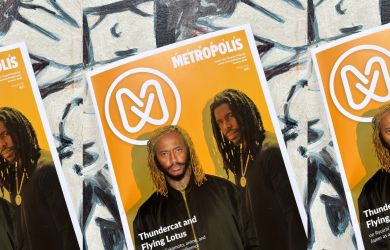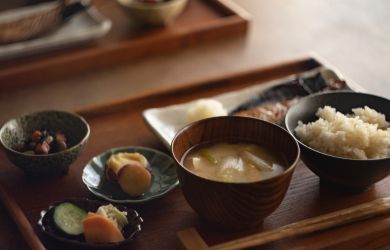
Originally published on metropolis.co.jp on August 2008
On a recent rainy night, we dashed into the warm cave of Shilingol. The stairs down to the basement were littered with curious artifacts: Mongolian bows, massive smooth bones bleached by the sun, a wolf pelt with the head still on. The room was slightly smoky and the Mongolian cook seemed to have six hands: sautéing, stirring and serving from the open kitchen. We shook off the rain and pulled off our shoes, settling into the ger—a gauzy canopy above a bright wooly carpet.
A waiter soon appeared bearing smooth white bowls of salty Mongolian milk tea and gestured to the large translucent salt crystals to grate into our tea. Throughout the dinner we pointed out each new object that caught our eyes—an impressive leather armor studded with gold and hanging from the aircon, a tapestry with the face of Genghis Kahn, a children’s book about Mongolia, a pair of horse figurines with real horse hair, a weathered bag of tools.
Gol, the restaurant’s tabby cat sauntered in, rubbing up against diners but never begging. It was clear by Gol’s paunch that he’ll be taking our leftovers. We were told to order before the music begins at a little after 8pm, and decided on the full nine-course dinner for ¥4,000.
The first three courses arrived: sliced cucumbers with fresh chili peppers doused in a savory Chinese black vinegar; raw potato shredded and slightly picked with julienned bell peppers; and soft tofu with scallions and a whisper of something that tasted like an ancho chili.
The lights dimmed and the cook appeared, having changed into royal blue Mongolian garb and curving leather boots. He smoothed his black hair in its ponytail, furrows his high wide forehead, and picked up his horse-head fiddle. With only two strings he evokes the hollow, poignant sound of the plains, like wind with nowhere to go. The music turns suddenly to horses galloping, the notes tumbling over each other. We applauded and our cook-turned -musician returned to the kitchen.
Next we tried the Amil (¥420), Mongolia’s answer to Calpis, and then the lamb arrived. The first incarnation was simple—caveman bones with the meat falling off in mouthwatering chunks. As this was only the fourth course of nine, we realized we are in for the ironman of eating. Fifth was a boiled lamb dumpling, hand-formed and swimming in a light broth. Sixth was steamed bao with a scallion-lamb filling, rare, chewy and salty. We started to wonder how much lamb one can consume. Seventh was shabu-shabu: cabbage, scallions, glass noodles, a complex sesame sauce with fermented flowers of spring onion, and of course, an unconquerable mound of thinly sliced lamb that cooks instantaneously.
At this point we started laughing—a lifetime of lamb could not possibly stack up against this feast. The eighth course was gooey udon noodles, and finally we arrived at the ninth: golden fried bread with sweetened condensed milk. We were buoyant and satiated for our long walk home.









